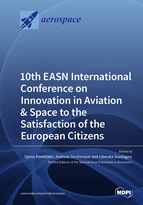10th EASN International Conference on Innovation in Aviation & Space to the Satisfaction of the European Citizens
A special issue of Aerospace (ISSN 2226-4310).
Deadline for manuscript submissions: closed (15 December 2020) | Viewed by 63511
Special Issue Editors
Interests: aeronautical materials and structures; mechanical behaviour of materials; structural integrity; damage mechanics; experimental fracture mechanics; fatigue of aircraft materials and structures; ageing aircraft; characterization and manufacturing processes of polymers, thermosetting and thermoplastic composites; nanocomposites and nanocrystalline alloys; multifunctional and self-healing materials
Special Issues, Collections and Topics in MDPI journals
Interests: aircraft design; conventional and unconventional configurations; aircraft systems; operational aspects; certification; electric and hybrid-electric flight; alternative propulsion systems; flight testing; unmanned aerial vehicles; scaled flight testing
Special Issues, Collections and Topics in MDPI journals
Interests: smart materials; study of the correlations between chemical-physical properties, structure, morphology and durability of macromolecular systems with different types of organizational architectures; design and development of new materials and materials applicable in the field of sensors; carbon–carbon composites (CCCs); thermosetting resins; mechanical properties; supramolecular interactions
Special Issues, Collections and Topics in MDPI journals
Special Issue Information
Dear Colleagues,
This Special Issue is cooperating with the 10th EASN International Conference on “Innovation in Aviation & Space to the Satisfaction of the European Citizens” (https://easnconference.eu), which will take place in Salerno, Italy from the 2nd until the 5th of September, 2020. The conference venue will be located at the Fisciano Campus of the University of Salerno.
The aim of this gathering is dual: to act as a forum where innovative ideas, breakthrough concepts, and disruptive technologies are presented, while in parallel to be the place for disseminating the knowledge and results achieved in the frame of research projects of the aviation and space field. The previous EASN International Conference, held in Athens, Greece in September 2019, was the most successful amongst the events organized by EASN so far and was attended by more than 450 participants from various disciplines.
Like its predecessors, the 10th EASN International Conference will include a number of Plenary Talks by distinguished personalities of the European Aviation and Space sectors from the academia, industry, research community and policy makers. It will also include Thematic Sessions, along with Technical Workshops where evolving ideas, technologies, products, services and processes will be discussed.
Furthermore, the conference is expected to be a major European Dissemination and Exploitation event of aviation and space-related research. The majority of the currently running research projects will exploit the 3-day technical program to present their activities and achieved goals, discuss on current trends and future needs of the aviation and space-related research, and try to identify possible synergies with each other. Additionally, a number of policy development projects will also be given the floor with the aim to present the strategic priorities of the European aviation sector with regard to the challenges of FlightPath2050 and the expected “Horizon Europe” Framework Programme.
Last but not least, the 10th EASN International Conference will be accompanied by a small exhibition where the overview of the aviation and space ecosystem in Italy will be presented.
Authors of outstanding papers related to aviation and space are invited to submit extended versions of their work to this Special Issue for publication.
Prof. Dr. Spiros Pantelakis
Prof. Dr. Andreas Strohmayer
Prof. Dr. Liberata Guadagno
Guest Editors
Manuscript Submission Information
Manuscripts should be submitted online at www.mdpi.com by registering and logging in to this website. Once you are registered, click here to go to the submission form. Manuscripts can be submitted until the deadline. All submissions that pass pre-check are peer-reviewed. Accepted papers will be published continuously in the journal (as soon as accepted) and will be listed together on the special issue website. Research articles, review articles as well as short communications are invited. For planned papers, a title and short abstract (about 100 words) can be sent to the Editorial Office for announcement on this website.
Submitted manuscripts should not have been published previously, nor be under consideration for publication elsewhere (except conference proceedings papers). All manuscripts are thoroughly refereed through a single-blind peer-review process. A guide for authors and other relevant information for submission of manuscripts is available on the Instructions for Authors page. Aerospace is an international peer-reviewed open access monthly journal published by MDPI.
Please visit the Instructions for Authors page before submitting a manuscript. The Article Processing Charge (APC) for publication in this open access journal is 2400 CHF (Swiss Francs). Submitted papers should be well formatted and use good English. Authors may use MDPI's English editing service prior to publication or during author revisions.
Keywords
- Aerostructures: Manufacturing
- Aerostructures: Materials
- Flight Physics
- Propulsion
- Avionics, Systems & Equipment
- Air Traffic Management & Airports
- Human Factors
- Innovative Concepts & Scenarios
- Industry 4.0 & Factories of the Future
- Space Technologies
- Space Applications and Operations
- Space Policies
- Environmental, Recycling and Disposal strategies
- Safety, Regulation and Standards
- Synergies and Technology Transfer with the Automotive Industry
- European Policy Actions in the Field of Aviation & Space
Related Special Issues
- 9th EASN International Conference on Innovation in Aviation & Space in Aerospace (9 articles)
- 8th EASN-CEAS Workshop on Manufacturing for Growth and Innovation in Aerospace (10 articles)
- 13th EASN International Conference on Innovation in Aviation and Space for Opening New Horizons in Aerospace (15 articles)
- 11th EASN International Conference on Innovation in Aviation & Space to the Satisfaction of the European Citizens in Aerospace (20 articles)
- 12th EASN International Conference on Innovation in Aviation & Space for Opening New Horizons in Aerospace (20 articles)








